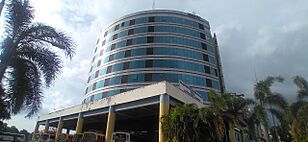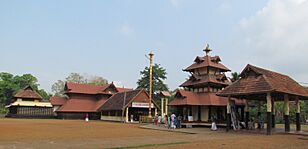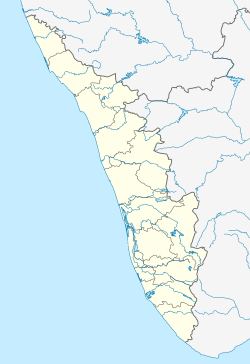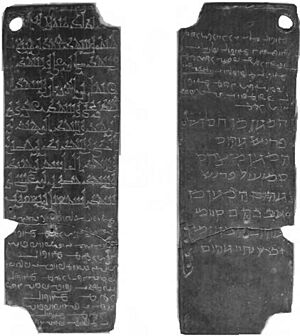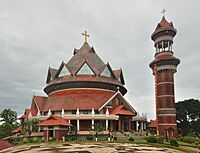Thiruvalla facts for kids
Quick facts for kids
Thiruvalla
|
|
|---|---|
|
Municipality
|
|
|
From top to bottom: 1.KSRTC Terminal Complex is one of its four BOT depots 2.Panoramic view of SCS Junction. 3.Sreevallabha Temple
|
|
| Country | |
| State | Kerala |
| District | Pathanamthitta |
| Area | |
| • Total | 27.15 km2 (10.48 sq mi) |
| Elevation | 14 m (46 ft) |
| Population
(2011)
|
|
| • Total | 52,883 |
| • Density | 1,948/km2 (5,050/sq mi) |
| Languages | |
| • Official | Malayalam, English |
| Time zone | UTC+5:30 (IST) |
| PIN |
689101
|
| Telephone code | 91-469 |
| Vehicle registration | KL-27 |
Thiruvalla, also spelled Tiruvalla, is a town in Kerala, India. It is located in the Pathanamthitta district. This town is the main office for the Thiruvalla taluk.
Thiruvalla covers an area of about 27 square kilometers. In 2011, its population was 52,883 people. The town sits on the north side of the Manimala River. It is surrounded by many canals and rivers. Thiruvalla is the largest town in its district. It is also a key center for money, education, healthcare, culture, and business in central Travancore.
Thiruvalla is often called the "Town of Non-Resident Indians." This is because many people from Thiruvalla live and work in other countries. Even though many people move away, the town's economy has been growing. It has also seen new life in its urban areas recently.
Contents
What's in a Name?
There are two main ideas about how Thiruvalla got its name.
The River Theory
One idea is that the name "Thiruvalla" comes from "Valla Vaay." This name was given to the Manimala River. In old Malayalam, "vāy" means 'mouth of a river'. Before good roads were built, Thiruvalla grew at the mouth of the Vallayār river. It connected many places using waterways. So, it was known as Valla vāy. Later, the Malayalam word "Thiru" was added. This word means something respected or holy. That's how it became "Thiruvalla."
The Temple Theory
The second idea comes from an old Sanskrit book from the 10th century. This book is called "śrīvallabha kṣētra māhātmyaṁ." It says the name comes from a major temple in the town. This temple is the Sreevallabha Temple. So, Thiruvalla comes from "śrīvallabhapuraṁ." This means "the town of Vallabha."
A Look Back in Time
Early Days
People have lived in the Thiruvalla area since about 500 BCE. But a proper town only started around 800 CE. Parts of Thiruvalla, like Niranam and Kadapra, were under the sea a long time ago. Thiruvalla is one of the 64 old brahmana graamams. These were important settlements for Brahmins.
Stone axes found in Thiruvalla show that people lived here during the Stone Age. The Aryan culture saw Thiruvalla as one of Kerala's important Brahmin settlements. An ancient writer named Ptolemy mentioned the Baris river. This is now the Pamba river.
Thiruvalla was also a big trading center long ago. It had the Niranam port. This port was called "Nelcynda" by another ancient writer, Pliny. The sandy soil and seashells found in western Thiruvalla today show that it might have been a coastal area. This was before the Kuttanad region was reclaimed from the sea.
The Rise of Feudalism
Until the early 900s CE, the Ay kings were powerful in Kerala. They ruled from Thiruvalla in the north to Nagercoil in the south. By the 1100s, we learn a lot from the Thiruvalla copper plates. These are very old records about life around the temple.
The Thiruvalla temple had a large school for Vedic learning. It was like a big university back then. This school was one of the most important learning centers in Kerala. The Thiruvalla school was very rich. The copper plates show that students were fed a lot of paddy every day. This tells us how many students were there. Thiruvalla was a very important place for learning and spiritual life in ancient times.
The Sri Vallabha Temple was one of the richest temples in old Kerala. This is clear from the writings on the copper plates. The land needed to feed the Brahmins required huge amounts of rice seeds. Also, a lot of paddy seeds were needed to keep the "eternal lamps" burning. Because they are so long, old, and written in an early form of the language, the Thiruvalla copper plates are called the "First book in Malayalam."
More Recent History
Later, the Thekkumkoor Dynasty ruled Thiruvalla. One of their main centers was near Kaavil Temple. The Thekkumkoor kings lost control around 1752–53. This happened when Marthanda Varma, the king of Travancore, took over the area. Some say it was a bloody battle, while others say it was a peaceful surrender.
Land and Weather
Geography
Thiruvalla is about 14 meters above sea level. It is located along the north bank of the Manimala River. Many natural canals, called "thodu" in Malayalam, cross through Thiruvalla. These include Chanthathodu and Manippuzha.
Thiruvalla has different types of soil. This is because it is between the low-lying Kuttanad region and the higher Midlands. The main town area has soil from rivers. The eastern parts have a reddish, clay-like soil. The western parts near Niranam have sandy soil, like beaches. The sandy soil in Niranam is there because this area was once on the coast of the Vembanad Lagoon. This was before Kuttanad was reclaimed from the sea.
Climate
Thiruvalla has a tropical monsoon climate. This means it gets a lot of rain for most of the year. There is a short dry season, but it doesn't change the overall climate much. The average temperature here is about 27.3 °C. Each year, the town gets about 3298 mm of rain.
April is the hottest month, with an average temperature of 29.0 °C. July is the coolest month, with an average of 26.4 °C. The difference in rainfall between the driest and wettest months is about 574 mm. January is the driest month, with only about 22 mm of rain. June gets the most rain, with an average of 596 mm.
Because Thiruvalla is close to the equator, its average temperature doesn't change much. The temperature only varies by about 2.6 °C throughout the year.
Thiruvalla is known for its pleasant weather. Heavy rains come from the South West Monsoon winds around August. The best time to visit is after the rains. The monsoon showers make the area very green and beautiful.
People of Thiruvalla
| Historical population | ||
|---|---|---|
| Year | Pop. | ±% |
| 1901 | 7,969 | — |
| 1911 | 12,010 | +50.7% |
| 1921 | 14,489 | +20.6% |
| 1931 | 18,002 | +24.2% |
| 1941 | 18,002 | +0.0% |
| 1951 | 20,709 | +15.0% |
| 1961 | 24,242 | +17.1% |
| 1971 | 26,683 | +10.1% |
| 1981 | 29,225 | +9.5% |
| 1991 | 54,780 | +87.4% |
| 2001 | 56,837 | +3.8% |
| 2011 | 52,883 | −7.0% |
| * 1991: Rise in population due to merger of Kuttapuzha village | ||
In 2011, Thiruvalla had a population of 52,883 people. There were about 1,948 people per square kilometer. Of the total population, 48% were male and 52% were female. About 7.48% of the people were under 6 years old.
The total literacy rate in Thiruvalla was very high, at 97.64%. This means almost everyone can read and write. For males, it was 98.05%, and for females, it was 97.28%. This is higher than the average for Kerala and India.
Religions
Religion in Thiruvalla (2011) Christianity (48.03%) Hinduism (46.92%) Islam (4.8%) None (0.21%) Other (0.06%)
According to the 2011 census, Christians make up the largest group in Thiruvalla. About 48% of the people follow Christianity. Most of these Christians belong to the St. Thomas Christian community. Hindus are also a large group, making up 46% of the population. Muslims make up about 5% of the population.
Thiruvalla is home to the Sree Vallabha Temple. This temple is special because it is the only one in Kerala where Kathakali is performed almost every night as a religious offering.
Sports and Fun
Football and cricket are very popular sports in Thiruvalla. The town has a rich history in football. A famous footballer from Thiruvalla was Thomas Varghes, known as "Tiruvalla Pappan." He played for India in the 1948 London Olympics. He was known as one of India's best defenders in the 1940s and 1950s.
Today, Thiruvalla hosts many football and cricket events. These include district and state-level tournaments. The Thiruvalla Municipal Council maintains a stadium in the town. This stadium, also called "Prithi stadium," is where most tournaments take place.
Indoor Cricket Facility
The Kerala Cricket Association has built an indoor cricket stadium complex in Thiruvalla. It offers practice facilities 24 hours a day, 7 days a week. This facility is next to the Thiruvalla Municipal stadium. It covers 8000 square feet and has special natural grass wickets for practice. The complex also has a library, a gym, a board room, and a conference hall. This indoor cricket facility is one of the first of its kind in Kerala.
Culture and Events
Thiruvalla hosts various cultural events. These include colorful flower shows and exciting food festivals.
Famous People from Thiruvalla
- Anna Rajam Malhotra, Indian Administrative Service officer
- Thenmadom Varghese, Indian professional footballer
- Poykayil Yohannan, social activist, poet
- Vennikkulam Gopala Kurup, poet
- Abraham Kovoor, hypnotherapist and rationalist
- Abu Abraham, cartoonist
- Dr. M.M. Thomas, former Governor of Nagaland
- Baselios MarThoma Didymos I, Malankara Metropolitan and Catholicos of Malankara Orthodox Syrian Church
- Babu Thiruvalla, movie director and producer
- Blessy, movie director
- C. K. Ra, artist
- C.P. Mathen, banker and founder of the Quilon Bank
- C J Kuttappan, folklore artist
- Col. Jojan Thomas, military officer
- John Abraham, movie director
- K. G. George, movie director
- Kakkanadan, novelist and writer
- Mar Athanasius Yohan I Metropolitan (formerly Dr K.P. Yohannan Metropolitan), Metropolitan Bishop of Believers Eastern Church
- Mathew T. Thomas, politician
- M. G. Soman, movie actor
- Nayanthara (Diana Mariam Kurian), movie actress
- Shalini, actress
- Kaveri, movie actress
- Meera Jasmine (Jasmine Mary Joseph), movie actress
- Nadiya Moythu, movie actress
- Parvathy Jayaram (Ashwathy Kurup), movie actress
- Oormila Unni (actress), movie actress
- Sreeja Chandran, actress
- Kaviyoor Ponnamma, actress
- Kaviyoor Sivaprasad, film director
- Sidhartha Siva, actor, director
- Samvyuktha Verma, movie actress
- Kailash, movie actor
- Rajeev Pillai, movie actor
- Sajeev John, physicist
- Vishnu Vinod, cricketer
See also
 In Spanish: Thiruvalla para niños
In Spanish: Thiruvalla para niños


